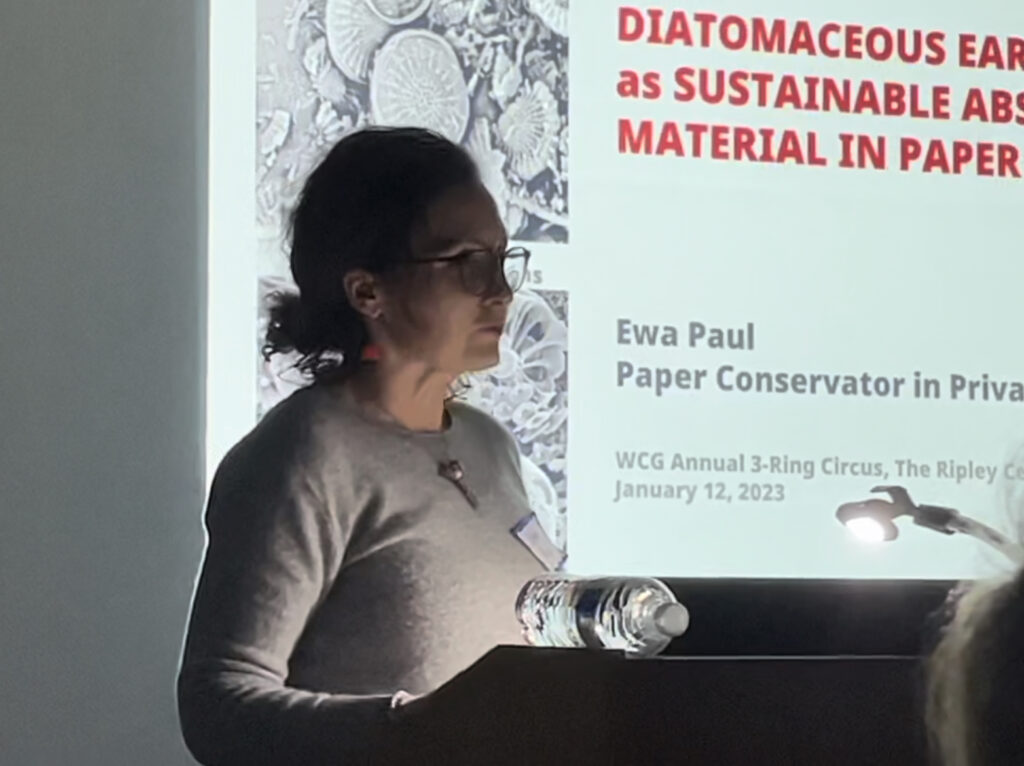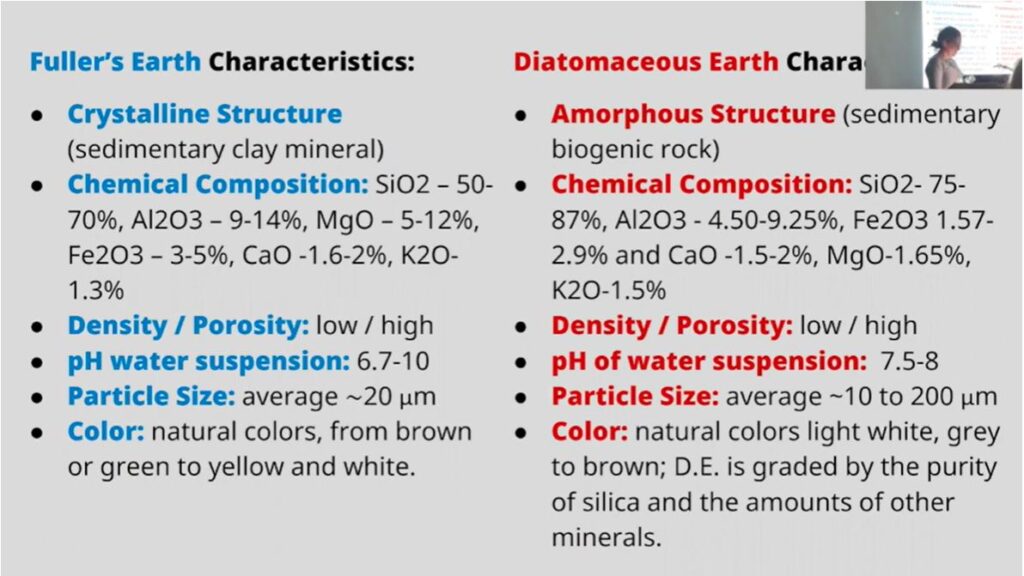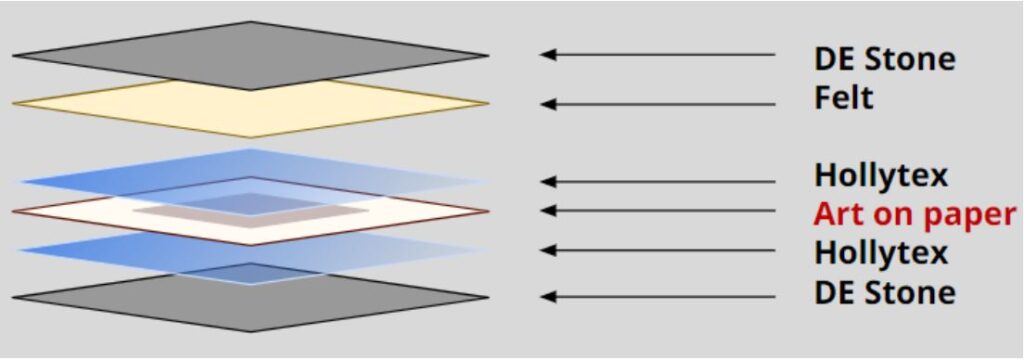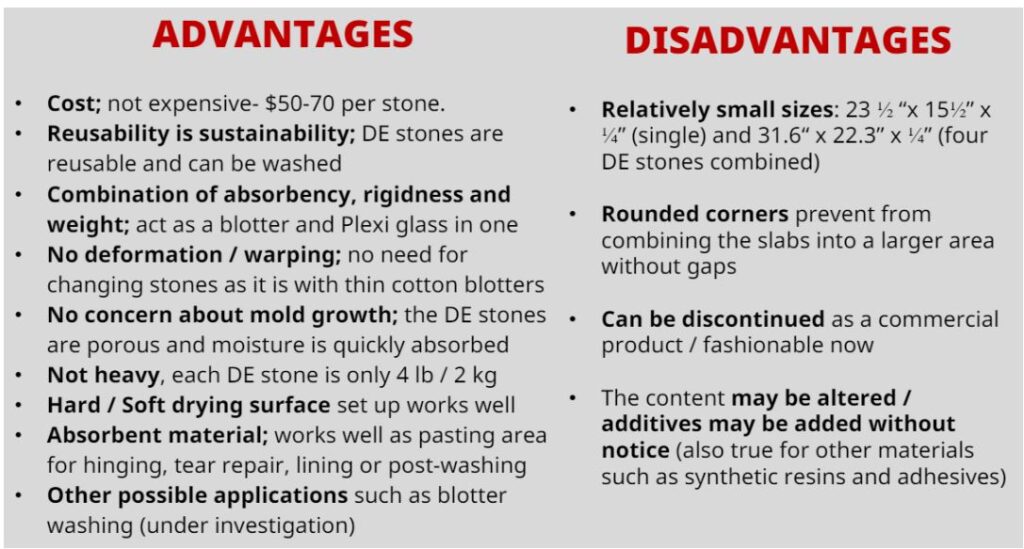Ring 1: WHAT’S OLD IS NEW
“Diatomaceous Earth Stones for Paper Conservation”
Presented by Ewa Paul, Paper Conservator in Private Practice
Summarized by Lauren Gottschlich
Ewa Paul’s talk evaluated a unique material, diatomaceous earth bathmat stones, and its viability for paper conservation. This commercial product could change the sustainability practices in paper conservation. The bathmats are composed of diatomaceous earth, a diatom-rich, biogenic sedimentary rock. Manufacturers producing these diatomaceous earth bathmats claim that these products are all-natural, absorbent, and inherently bacteria and mold resistant. Paul wished to verify these claims to determine whether the bathmats could be used as a sustainable, reusable alternative for blotter in paper conservation.
First, Paul described the structure and characteristics of diatomaceous earth. Diatomaceous earth is composed of diatoms. These single celled, aquatic organisms are varied with over 30,000 species. They range in size from 5 micrometers to 100 micrometers, and therefore require a microscope to view in detail. Paul shared a beautiful video of the varieties and shapes of these incredible organisms.

Then, she briefly compared some characteristics of diatomaceous earth and Fuller’s earth. Both materials have similar density, porosity and chemical makeup (with different elemental percentages). However, while sharing some similarities, diatomaceous earth differs from Fuller’s Earth in structure and properties. Fuller’s Earth is a crystalline material and is derived from clay minerals, while diatomaceous earth is amorphous and comes from skeletons of living organisms. Fuller’s earth is also not inert, it is capable of cationic exchange and has great adsorption capabilities.

For the analysis, bathmats from the brands Dorai and Sutera were selected. Paul noted that this presentation is not an endorsement of these two brands. Rather, these two brands were the ones selected out of many available on the market. Diatomaceous earth stone products come in many sizes, the largest being the bath mat (24” x 15” x ¼”). The pH of the surface was tested using pH test strips and was determined to be between 8.5 and 9.
Ewa Paul and Jennifer Herrmann (PhD), a scientist at NARA, conducted the XRF and FTIR of the bathmats at the Heritage Science Lab. The primary objectives were to identify the composition of the mats and to determine if the mats transferred any material to paper during the drying process.
First, the bathmat stones were analyzed to determine their composition. The findings of the XRF analysis were that the bathmats were consistent with diatomaceous earth. The peaks in the spectra included elements expected with diatomaceous earth such as calcium, aluminum, silicon, potassium, iron, zinc, strontium, and sulfur. No elements were found that correlated to other materials.
FTIR spectra confirmed that the bathmat stones were composed of mostly silicates and carbonates and no organic (carbon-hydrogen) bonds were detected. Therefore, based on these findings, it was concluded that the diatomaceous bath mats being manufactured at this time contained diatomaceous earth and did not contain any harmful organic additives or other substances.
Next, samples of Whatman filter paper were dried in direct contact with the diatomaceous earth bathmats for testing. Once dry, these paper samples along with the control paper sample underwent XRF and FTIR analyses to determine if anything transferred from the mats into the paper. XRF detected no inorganic material consistent with the composition of the stone, suggesting that there was no transfer of material from stone to paper. Additionally, FTIR found nothing consistent with the bathmat stones or any foreign organic material in the paper samples. Therefore, it was concluded that the bathmats tested did not transfer anything to the paper during the drying process.
Lastly, Paul highlighted some treatment options and listed the pros and cons of the use of diatomaceous earth bathmats. She noted that these bathmats can be combined to create a larger surface area and be used as an absorbent receiving surface for artifacts removed from aqueous baths (brushing the object through a sheet of isolating Hollytex layer is recommended to ensure even contact). An example of an etching dried between a diatomaceous earth bath mat stone and a woolen felt, and another diatomaceous earth bath mat placed on top was presented (diagram below). The result was consistent with prints dried under blotter paper.


Paul noted that variations to the drying process are possible; replacing the top diatomaceous earth bath mat stone with felt will preserve pronounced plate marks. In either configuration, with or without the felt, the moisture is absorbed into the stone much like to the blotter paper. Paul also noted that the smaller diatomaceous earth stone products such as coasters, can be ideal for drying small mends. The diatomaceous earth coasters can also be used for pasting out hinges. The moisture in the applied paste is quickly reduced and the resulting hinge is less likely to create tidelines which is important when dealing with unwashed paper. The pros and cons were laid out in clear detail in the slide below.

Major advantages of using the diatomaceous earth bathmat stones are reusability, absorbency, lack of deformation and low cost. However, it is important to note that these bathmats are commercial products and their makeup can be changed by the manufacturer without notice. Additional testing is currently being done at the Heritage Science Lab and the results remain promising and will be presented in a poster at the upcoming AIC conference in Jacksonville, FL.
If you missed this talk and would like to see it in all of its great detail, please check out the Washington Conservation Guild’s YouTube page. There you can find recordings of this talk and many others!